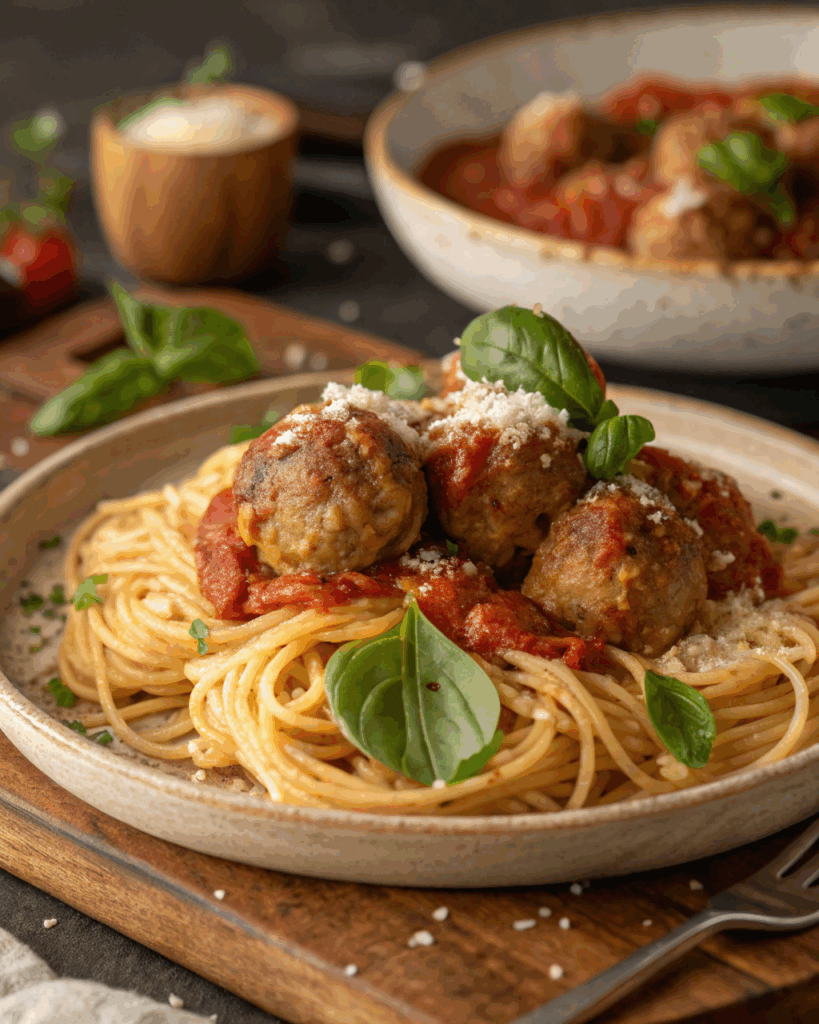Traditional Beef & Mushroom Stroganoff – Creamy Classic is comfort food with heritage: a 19th-century Russian creation that made its way from aristocratic dining rooms to home kitchens worldwide. Picture tender seared beef, buttery mushrooms, and a tangy, silky sauce kissed with sour cream. It’s weeknight-simple when you know a few tricks, yet elegant enough for guests—my favorite kind of healthy recipe makeover candidate for home cooks who want full flavor without fuss.
- Personal note: I learned to make stroganoff from a retired hotel chef who swore by two rules—“brown boldly, finish gently”—and I think of him every time the mushrooms squeak in a hot pan.
- Ingredient spotlight: Sour cream is the soul of stroganoff. Buy full‑fat, cultured sour cream (no stabilizers if possible) or crème fraîche; skip “light” versions, which can split. Smart swap: thick, whole-milk Greek yogurt for a tangy, lighter finish.
- Technique tip: Curdling is the common pitfall. Keep the sour cream off direct heat—stir it in after you’ve taken the pan off the burner—and temper it first with a little hot sauce from the pan. Mushrooms watery? Sear in batches and salt only after browning.
A quick origin note: The dish likely traces to the Stroganov family, whose French-influenced Russian cooks folded sour cream into pan juices to make a rich, café-style sauce. Over time, mushrooms and paprika joined the party, and the duo of beef and mushrooms became the signature.
This version leans classic in technique while offering options for modern kitchens: how to choose the right cut of beef, which mushrooms bring the most aroma, and how to manage heat so your sauce turns glossy instead of grainy. If you’re looking for a healthy recipe angle, you’ll also find simple swaps that keep the spirit intact—like Greek yogurt for sour cream, cornstarch instead of flour for gluten-free thickening, and leaner cuts of beef without losing tenderness.
Below, I’ve collected everything you need to shop smart, season with confidence, and serve a bowl that tastes like you cooked far longer than you did.
What makes it a “creamy classic”
- Tang plus umami: Sour cream (or crème fraîche) for tang, beef stock for body, Dijon and Worcestershire for depth.
- Proper browning: Golden mushrooms and a quick sear on beef ensure a rich, layered sauce without heavy cream.
- Gentle finish: Dairy is folded in off heat so the sauce stays silky.
Choosing the beef (tenderness without guesswork)
- Best cuts: Top sirloin, tri-tip, or ribeye are flavorful and quick-cooking. Tenderloin is luxe and tender but pricier. Avoid long-braise cuts (chuck, round) unless you plan a separate braise before finishing with the sauce.
- Slice smart: Cut across the grain into 1/4-inch (6 mm) strips. Thin slices cook fast and stay tender.
- Season early: A light sprinkle of salt 20–30 minutes before cooking helps the interior season evenly.
- Optional quick-tenderizing: For lean sirloin, a tiny pinch (1/4 tsp / 1 g) of baking soda on the surface tossed with the beef and rested 15 minutes helps keep it supple. Don’t overdo it; too much turns spongy.
Mushroom matters (flavor first)
- Type: Cremini (baby bellas) bring a deep, woodsy base; add a handful of shiitakes for savory punch. If you want restaurant-level aroma, a small amount of dried porcini (rehydrated and strained) adds haunting depth.
- Clean and dry: Wipe mushrooms; avoid soaking. Moisture inhibits browning.
- Pan management: Cook in batches; crowding steams them. Don’t salt until they’ve taken on color.
Sour cream, crème fraîche, or yogurt?
- Classic: Full-fat cultured sour cream offers the right tang and fat to emulsify smoothly.
- Crème fraîche: Naturally stable and glossy; it won’t curdle as easily. Use a bit less because it’s richer.
- Greek yogurt: A healthy recipe favorite—thick and tangy. Choose whole-milk (5% fat), and temper before adding. A teaspoon of cornstarch whisked into the yogurt helps stabilize it.
The flavor architecture (little details, big payoff)
- Alliums: A mellow yellow onion provides sweetness; a couple of garlic cloves add warmth.
- Mustard: A spoonful of Dijon sharpens and balances the dairy.
- Paprika: Sweet Hungarian paprika contributes color and a subtle pepperiness. Avoid smoked paprika as it dominates.
- Umami lift: A few drops of Worcestershire deepen savoriness; soy sauce or fish sauce are minimalist alternatives (just a dash).
- Acid: Finish with a squeeze of lemon to brighten without making it sour.
- Herbs: Thyme builds a foresty note; parsley adds freshness at the end.
Stock and deglazing
- Stock choice: Use good low-sodium beef stock so you control seasoning. If using store-bought, aim for brands with short ingredients lists and no caramel color.
- Deglaze options: A splash of dry sherry, white wine, or brandy dissolves the fond and brings gentle sweetness. If you prefer alcohol-free, use stock and a teaspoon of apple cider vinegar.
Heat control and pan choice (your insurance policy)
- Pan: A wide, heavy stainless-steel skillet (or well-seasoned cast iron) over medium-high heat maximizes browning. Avoid small or thin pans that trap moisture and scorch.
- Sequence: Brown first, simmer second, dairy last. That order keeps textures pristine and the sauce smooth.
- Off-heat finish: When the sauce base tastes balanced, turn off the heat, stir in the tempered sour cream, and warm with residual heat only.
Gluten-free and other dietary notes
- Gluten-free: Dust beef with cornstarch instead of flour, and thicken the sauce with a cornstarch slurry (2 tsp / 6 g cornstarch + 2 tbsp / 30 ml water). Serve with gluten-free egg noodles, rice, or mashed potatoes.
- Halal: Use halal-certified beef and stock; skip wine or brandy and deglaze with stock plus a tiny splash of apple cider vinegar.
- Lighter dairy: Whole-milk Greek yogurt or light sour cream can work with careful heat; stabilize with 1–2 tsp cornstarch whisked in.
Healthy recipe tweaks that still taste classic
- Lean cut, big flavor: Trimmed sirloin offers excellent flavor; careful slicing and quick searing keep it tender.
- More mushrooms: Increase mushrooms to stretch portions and add nutrients without extra calories.
- Balanced fat: Use a mix of butter and olive oil to steady browning without going overboard on saturated fat.
- Sodium sense: Choose low-sodium stock; season in layers and taste at the end.
- Portion and plate: Serve over a bed of whole-grain egg noodles or brown rice, and add a crisp, acidic salad to balance richness.
Common pitfalls and how to fix them
- Mushrooms are pale and wet: The pan was crowded or not hot enough. Cook in batches and don’t salt until browned.
- Beef turned tough: The slices were too thick or cooked too long. Cut thinner next time and sear just to medium-rare; they’ll continue to warm in the sauce.
- Sauce split: The sour cream hit high heat. Temper first and stir in off heat; if it splits, whisk in a splash of cold water and a teaspoon of crème fraîche to re-emulsify.
- Too thin: Reduce the sauce before adding dairy, or whisk in a small cornstarch slurry and simmer gently for 30–60 seconds before finishing.
- Too tangy: Balance with a knob of butter and a pinch of sugar or a splash of cream to round sharpness.
Make-ahead, storage, and reheating
- Make-ahead: Brown mushrooms and build the sauce base hours in advance; keep the seared beef separate (undercooked slightly). Right before serving, warm the sauce to a gentle simmer, reintroduce beef briefly, then take off heat and fold in dairy.
- Storage: Refrigerate in an airtight container up to 3 days. Sauces with yogurt or sour cream are best within 48 hours.
- Reheating: Low and slow. Warm gently on the stovetop over low heat; add a splash of stock or water to loosen. Avoid boiling to prevent curdling.
- Freezing: Dairy-based sauces don’t freeze perfectly, but the base (without sour cream) freezes well for up to 2 months. Add dairy after thawing and reheating.
Sourcing tips and a quick grocery guide
- Beef: Look for even marbling. Sirloin cap or top sirloin gives great value. Ask the butcher to cut into 1/4-inch (6 mm) planks if you’re short on time.
- Mushrooms: Firm, dry caps with tight gills. Avoid packages with condensation or sliminess.
- Sour cream: Choose full-fat with minimal ingredients. Crème fraîche is a safe luxury if you need stability.
- Stock: Low-sodium beef stock or bone broth; keep a jar of Better-Than-Bouillon style paste for a flavor bump, but add gradually to avoid oversalting.
- Dijon and Worcestershire: Standard pantry brands are fine. Taste as you go; both are potent.
Why this version works for home cooks
- It respects the classic while being pantry-friendly. No rare ingredients required, and you can choose your thickener and dairy to fit your kitchen.
- It’s forgiving. Most elements can be adjusted at the end: acidity with lemon or Dijon, richness with butter or crème fraîche, and thickness with reduction or cornstarch.
- It scales effortlessly. Use a larger pan and cook in clear batches; otherwise, the method stays the same.
Flavor variations (without losing the core)
- Porcini boost: Rehydrate 0.5 oz (14 g) dried porcini; strain and add the umami-rich liquid to the stock.
- Peppercorn bite: A few crushed green peppercorns for a bistro-style note.
- Herb swap: Tarragon instead of thyme for a French lean.
- Mustard-forward: Increase Dijon to 2 tbsp (30 g) for a sharper profile.
- Light smoke: A tiny pinch of smoked paprika (not traditional) can be nice, but keep it minimal so it doesn’t overshadow the mushrooms.
How to think about balance
Stroganoff’s magic is balance—richness from butter and beef, savoriness from browned mushrooms and stock, and a tangy lift from sour cream and mustard. If it feels heavy, add acid; if it feels sharp, soften with fat. If it lacks depth, return to your browning: that’s where the flavor was born.
Serving mood and occasion
It’s weeknight suitable yet dinner-party ready. I often serve it family-style in a warm shallow bowl, scattered with parsley and chives. Guests spoon it over buttered egg noodles, rice, or silky mashed potatoes, with a crisp green side to clear the palate between bites. It’s the kind of dish that quiets a table for a minute on the first bite, then sparks talk about the mushrooms.
Ingredients
Serves 4 generous portions.
- 1.5 lb (680 g) beef top sirloin or tenderloin, trimmed and sliced across the grain into 1/4-inch (6 mm) strips (sirloin for value and flavor; tenderloin for extra tenderness)
- 1.25 tsp (7 g) kosher salt, divided (season in layers; adjust to taste if using regular table salt)
- 3/4 tsp (2 g) freshly ground black pepper, divided
- 1 tsp (2 g) sweet Hungarian paprika (adds gentle color and warmth; avoid hot/smoked for a classic profile)
- 2 tbsp (16 g) all-purpose flour (optional; for light dredging and sauce body—use 2 tsp/6 g cornstarch for gluten-free)
- 1 tbsp (15 ml) olive oil (helps raise smoke point when combined with butter)
- 3 tbsp (42 g) unsalted butter, divided (2 tbsp for mushrooms/onions, 1 tbsp to finish; use ghee for higher heat)
- 1 lb (450 g) cremini (baby bella) mushrooms, sliced 1/4 inch (6 mm) (mix in 4–6 oz/115–170 g shiitakes for extra savoriness if you like)
- Optional umami boost: 0.5 oz (14 g) dried porcini mushrooms, soaked in 1 cup (240 ml) very hot water for 20 minutes, then drained and strained (add the clear soaking liquid to your stock; avoid gritty sediment)
- 1 large (10 oz / 280 g) yellow onion, thinly sliced (sweetness for balance)
- 3 cloves (12 g) garlic, minced (aromatic backbone)
- 2 tbsp (30 ml) dry sherry, white wine, or brandy (optional; for deglazing—use extra stock if avoiding alcohol)
- 1.5 cups (360 ml) low-sodium beef stock (plus up to 1/2 cup/120 ml more to adjust consistency, especially if using porcini liquid)
- 1.5 tbsp (22 g) Dijon mustard (adds brightness and complexity)
- 2 tsp (10 ml) Worcestershire sauce (or 1 tsp/5 ml soy sauce for a different umami route)
- 1 cup (240 g) full‑fat sour cream (classic choice; or use 3/4 cup/180 g crème fraîche for extra stability)
- Optional healthy recipe swap: 1 cup (240 g) whole-milk Greek yogurt (stabilize with 1 tsp/3 g cornstarch; temper before adding)
- 1 tsp (1 g) fresh thyme leaves (or 1/2 tsp/0.5 g dried thyme), plus more for finishing (earthy, subtle herb note)
- 2 tbsp (8 g) finely chopped fresh parsley (freshness and color for garnish)
- 1–2 tsp (5–10 ml) fresh lemon juice (to brighten at the end; add to taste)
- For serving: 12 oz (340 g) wide egg noodles (or mashed potatoes, buttered rice, spaetzle, or cauliflower mash for low-carb)
- Optional finishing richness: 1 tbsp (14 g) cold butter (whisked in off heat for gloss)
- Optional heat control: 1/8 tsp (0.5 g) cayenne or a pinch of white pepper (not traditional, but good for gentle warmth)
- Optional texture insurance (gluten-free): 2 tsp (6 g) cornstarch whisked with 2 tbsp (30 ml) cold water to make a slurry (only if the sauce needs thickening before adding dairy)
- Optional fresh chives, thinly sliced (for garnish; delicate onion aroma)
- Optional quick-tenderize aid: 1/4 tsp (1 g) baking soda (toss with beef and rest 15 minutes for lean sirloin; rinse and pat dry if you detect any alkaline aroma)
Notes and sensible swaps:
- Beef choice: If using ribeye, trim excess surface fat to prevent greasiness. If using tenderloin, reduce the sear time; it’s delicate.
- Mushrooms: If button mushrooms are all you have, toast them longer to develop flavor. Oyster mushrooms add a lightly sweet, silky texture.
- Stock: If your stock is strong, start with 1 cup (240 ml) and add more as needed to reach your preferred sauce consistency.
- Dairy: If using Greek yogurt, keep the pan off heat before adding; whisk in slowly. For extra insurance, whisk 1 tsp (3 g) cornstarch into the yogurt.
- Gluten-free: Replace any flour with cornstarch and use GF noodles or rice. Check labels on Worcestershire (some brands are gluten-free; others may contain barley malt).
- Acid and salt: Lemon amplifies salt perception. Always taste before adding more salt after the lemon.
What to Serve With
- Buttered wide egg noodles (or whole-grain noodles): The classic pairing; their nooks hold the sauce and the chew balances the creamy texture.
- Buttermilk mashed potatoes: Silky, slightly tangy mash mirrors the stroganoff’s creaminess while giving a plush base for the sauce.
- Steamed buttered rice or pilaf (white, brown, or wild): A neutral canvas that lets the savory sauce shine; wild rice adds nutty chew for contrast.
- Crisp cucumber-dill salad: Bright, cool crunch with a light vinaigrette cuts through richness and nods to Eastern European flavors.
- Roasted green beans or broccolini with lemon zest: Snappy, lightly charred greens add freshness and a citrus lift.
- Quick-pickled red onions or cornichons: Acidic snap and gentle sweetness sharpen each bite without overwhelming.
- Garlicky sautéed cabbage with caraway: Sweet-savory and low-effort; echoes classic regional sides while staying light.
Beverage pairings:
- Red wine: A medium-bodied Pinot Noir or Grenache complements mushrooms and beef without overpowering the sauce.
- White wine: An oaked Chardonnay or aged Riesling handles cream and umami gracefully.
- Beer: A malty brown ale or Vienna lager works with caramelized notes from the sear.
- Non-alcoholic: Sparkling water with lemon or a tart, unsweetened iced tea refreshes the palate between creamy bites.
Garnish ideas:
- A shower of chopped parsley and chives for freshness and color.
- A tiny spoonful of crème fraîche or sour cream swirled on top for extra gloss.
- A dusting of sweet paprika for color and a gentle aromatic hit.
For a lighter plate:
- Serve smaller portions over riced cauliflower or a bed of lightly wilted spinach, with extra mushrooms to stretch the dish—an easy way to keep it a satisfying healthy recipe without losing the classic feel.



